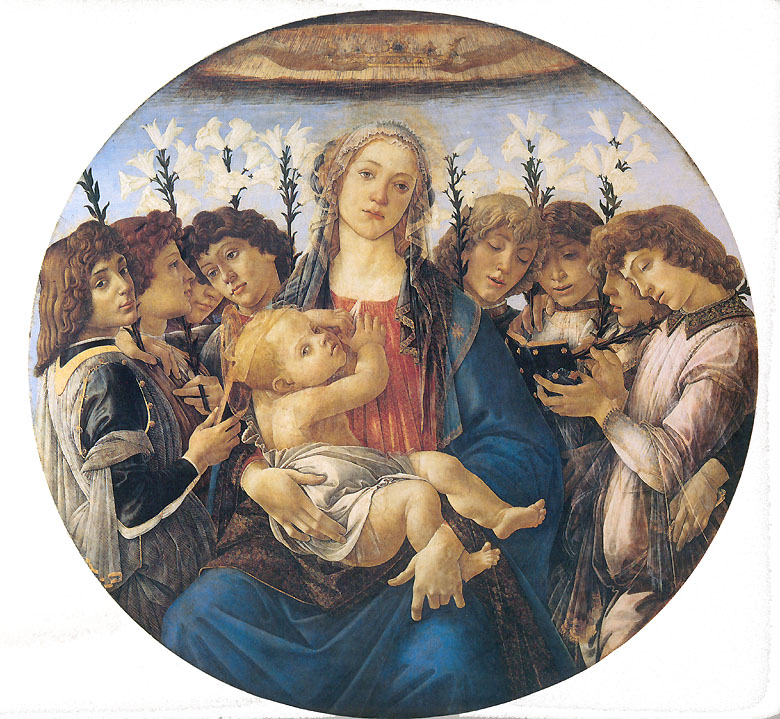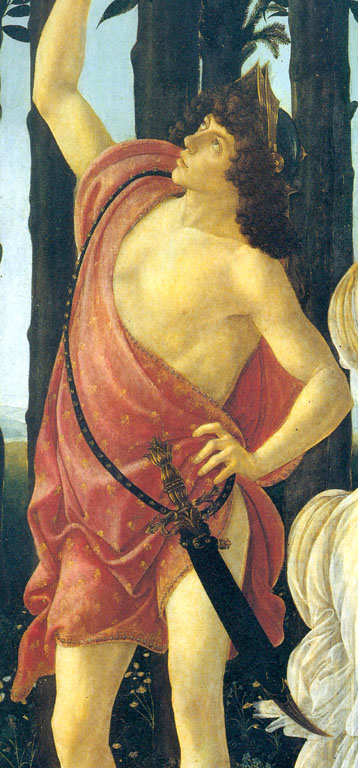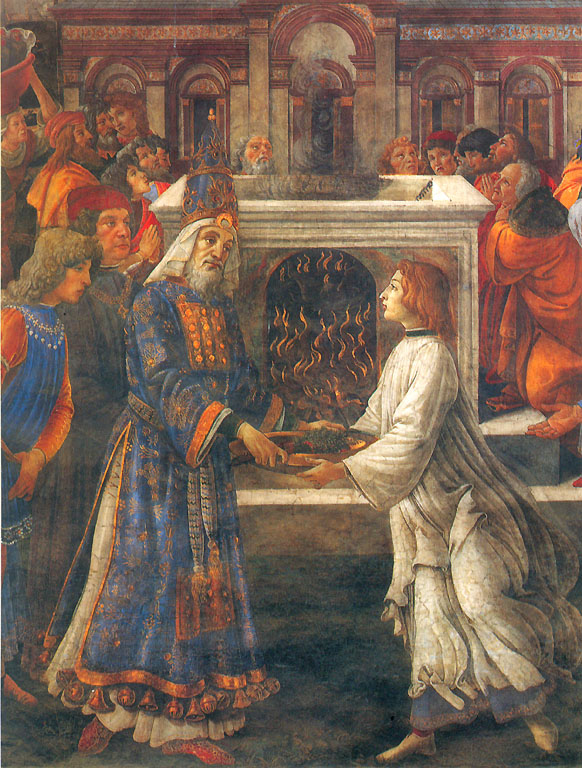Firenze is overflown with tales of high contrast and blood-boiling drama. I will get into them randomly as they emerge in my hazy mind.
1. Michelangelo's final Pieta.

Housed in the Duomo Museum behind the cathedral (with the Dome), this is probably Michelangelo's most personal work. He was 79 years old. Many of his friends and contemporaries had died. Death weighed heavily on his mind. Actually, I read somewhere that death had been on his mind as early as his teens. Haunted throughout his life by mortality and his own ugly appearance, he tried to capture the fleeting beauty of life and youth and freeze them. Perhaps we who succeed him could say that he won this race with death after all, but at the time of carving this 4-figure Pieta, he was literally hearing Death on his doorsteps.
All through his life, Michelangelo sold his genius to his clients (namely the pope or someone from the Medici family, which could mean the same thing). Every piece was commissioned. They told him to sculpt this and paint that, and he complied in his own way. But this Pieta was different. It was the first and only (?) time he sculpted for himself. The work was intended as his own tombstone. He had been given a burial place in the St. Peter's Church in Rome, and this sculpture would be on it. Later he changed his mind and was buried in Firenze, the tombstone an unmemorable piece by his biographer and friend Varasi.
So when the chisel in his aging hand dug into the marble and sparks went flying, he was summing up his life. He knew his place in history, and nobody would accuse him of being a modest man. The volunteer guide at the museum (probably an American art student) pointed out the important placement of the character St. Nicodemus in this sculpture who had a face of Michelangelo himself. He stood large at the apex of the entire structure, behind and above all other characters, including Jesus himself.
But the work was unfinished. He complained to others that the marble had ingrained flaws and unevenness that hindered his progress. It dragged on for 2 to 3 years. At some point, he might have made a mistake in the design as well. The guide pointed out that Jesus' left leg, which was supposed to dangle on Madonna's knees, could not have been successfully carved in the current position. Now this leg is broken at the thigh. We would never know the details, but at some point Michelangelo was mad enough to pick up a hammer and started destroying it.
Reportedly, his attempt at the destruction was triggered by the incessant harrassment from an assistance, who kept asking him when Pieta would be completed. Perhaps annoyed by the constant reminder that he had failed his last and most important work by and for himself, he broke Madonna's arm and some other components on the right side. Another assistant in his studio stopped him and took the work home. After Michelangelo's death, the assistant repaired the broken parts and tried to finish it. The attmept to imitate and "finish" a Michelangelo piece resulted in an awkward and polished figure of Mary Magdalene on the left side. Thankfully, even the imbicile could realize his own mistake (unlike some other imbiciles who commonly would not), and the rest of the sculpture, including Nicodemus, the one-legged Jesus, and Madonna with her face adhered to Jesus', all remained in the unfinished, almost abstract form as they were left by the master.
To me the most notable element in this story was Michelangelo's emotional state as he attacked his own work in a rage. Once again I felt this all made perfect sense. I certainly could not imagine his genius, but I suspect I could very well understand his overwhelming disappointment and anger at himself, perhaps at his age and frailty. The thing he feared the most, the loss of youth and vitality, had finally decended on him which seemed to have also taken away his great instinct and skills as an artist. What could be more devastating?
Yet strangely, the unfinishedness of this Pieta does not seem to reduce its power on the audience. You have to be in the room to sense the grief and despair pouring out of the unpolished stone.
The Pieta was so massively problematic that it probably could NOT have been made perfect, or even "right", in the first place. Remember it was Michelangelo himself who said that a sculpture is hidden in a raw piece of stone and the artist merely releases it by carving it out. It is as if the Pieta had been destined to be this rough, unfinished, impossible, half-adulterated, and unpolished sculpture. It is the perfect piece released onto the world because it is the only version. It is not any less moving or powerful, had it been finished and polished and everyone had two arms and two legs and a flawless face.
The funny thing is, a lot of Michelangelo's works were unfinished, including his Prisoners and Slaves (now in Accademia) intended for the tomb of Pope Julius II (the one who commissioned Sistine Chapel) and the Medici Chapel. His unfinished works showed exactly how he "freed" the hidden figures from the raw stone. I almost felt the unfinishedness, although unintentional, predicted and influenced aspects in modern art. Also, they are a persuasive argument against perfection and completedness in this world. Life is an unfinished and imperfect colossus that far surpasses any flawlessness.
***
My opinion of Michelangelo's orientation further confirmed by additional works of his I saw. Take, for example, the female nude in his group sculptures Dawn, Dusk, Night, and Day:

This is not a woman's body. This is a man's body with breasts! He was obviously not the least interested in a woman's body and perhaps had never taken a mistress in his whole life. His disinterest in women cannot be more apparent.
Yet I'd be lying if I say Michelangelo cannot do women well, artistically I mean. His Donni TOndo is one of my favorite paintings in Uffizi:
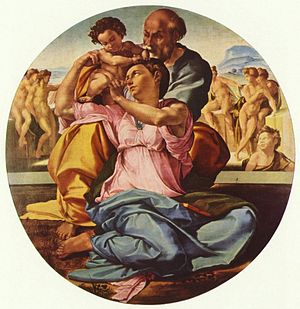
The Madonna in this vibrant, lively painting is unlike any of the other thousands of Madonnas I had been bombarded since I arrived in Italy. Rick Steves called her "the peasant woman." In his homosexual sensibilities, Michelangelo gave this Madonna almost a feminist aura. On the other hand, note the completely gratuitous male nudes in the background!
***
We were all slightly underwhelmed by the gigantic David at Accademia, despite its status as the most famous sculpture in the world. The author of "Where to Find... (Florence)" said something that rings true with me -- David is not a work by which Michelangelo is best judged. I take that as implying that David does not reflect Michelangelo's dominating style throughout his life. It's not easy to pin point why David is not typical Michelangelo, but I feel that it is closer to the harmonious, well balanced Greek ideals than his own later style.
David is perhaps a bit more muscular than the typical Greek statue, but he is nevertheless lean and long and idealistically shaped. His posture inherits the Greek approach that balances motion and stillness, almost unrealistically capturing both. The biggest point of departure is perhaps his oversized and powerful hands.
But Michelangelo went his own way after all, despite the undeniable heritage to the classical art. For the rest of his life, the figures are much more robust and rough, with bulky muscles and twisting postures. Harmony and smoothness were not his pursuits any more, it was tension and conflict, often within one figure. His taste are obvioiusly leaning in the direction of the laborer's body, not the graceful gods'.
Compare that with Leonardo Da Vinci, you can observe the clear difference in their preference to beauty. Leonardo's portraits all seem to have an androgynous effects. The creatures of his admiration are somewhere between male and female, with the qualities of both. It is no surprise, then, that he had the reputation of being fond of beautiful boys with soft, feminine features.
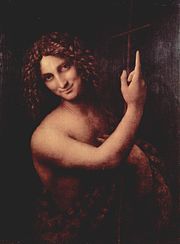 St. John the Baptist
St. John the Baptist Annunciation
Annunciation2. Donatello.
Donatello in Firenze is like Bernini in Rome: He left his mark on almost every corner of the city. He lived a very long and productive life.
This story in Vasari's Vite seems to illustrate perfectly Donatello's unique approach to art among his contemporaries: He was good friends with Brunelleschi. One day he showed Brunelleschi a wood carving of the Crucificion,

Brunelleschi was not impressed: "Wha? You've made Jesus into a peasant!" Brunelleschi then did his own version of wood Crucifiction

and took it to Donatello's house to show him how it should be done. Donatello was just coming home from the market with eggs and milk and other food in preparation of a dinner with his friend Brunelleschi. As he saw the work, he dropped all the food on the floor and exclaimed, "You are right. Yours is real Jesus, mine is just a peasant." Brunelleschi said, "Now what are we going to eat, huh?"
The funny thing is, I kind of like Donatello's peasant Jesus. When everyone around him was chasing the ideal human body and perfect harmony as touted by the ancient Greeks, Donatello's sculptures are unbeautiful. He was clearly an astute observer of the human condition as it is, not a fantasy in someone's head, and was able to present to you, the viewer, the beauty in the unbeautiful reality.
One of the most powerful pieces I saw in Firenze was his Mary Magdalene in the Duomo Museum:

The downward wavy lines in this wood sculpture and the dramatic, modern figure evokes the shapes and symbolism in many modern pieces. There is something unreal about the piece, something emotionally raw and unsettling.
He made all the prophets standing in the outside walls of the Duomo. Each of the prophet has a distinctive face and expression, no two are alike. One is particularly ugly:

The story went like this: The Medici family, who commissioned these sculptures, asked Donatello to model a lot of them on their friends and family members's faces. But they also want their enemy's face on one of the sculptures, and he must be made especially grotesque. Donatello seemed to have the most fun with this bald, ugly figure, I felt.
Was Donatello influenced by the rising humanist thoughts at the time? I am more inclined to believe that his style came from an inate curiosity and empathy for the oridinary, unglamorous people. He was more fascinated with their inward passions and individuality as manifested on the outside. He is my kind of artist.
I often claim to be for realism. Realism is not the same as naturalism. Merely transcribing reality wouldn't do. The tension between the universal reality and the individual reality has always haunted art. Art without subjectivity is dull, art without universality is meaningless.
Sticking with realism does not imply a lack of imagination and innovation. Rather, I am perpetually amazed by how real life, and people, outperform anyone's imagination. Life is stranger than fiction, because the human imagination is not equipped to dream up all the strange things we ourselves are capable of. Reality is so much more bizarre and fascinating than anyone's imagination. And so Donatello watched with amusement and created bodies and faces that reflect an inner truth that surprises me.
Donatello did not indulge in idealized figures, but an artist can't help by express every corner of himself. Even conscious efforts to hide oneself end up revealing something deep and personal about the artist himself (e.g., Nabokov's Lolita). Every guide book I read points out the strikingly soft and feminine characteristics of his David, the first male nude in God knows how long. He sure opened a flood gate.

It reveals quite clearly just what floats his boat. Need I say more?
Another incredibly powerful work by Donatello is the bronze Judith and Holofernes showing her at the moment of cutting off his head.

I had a moment of lapse of reason and skipped Palazzo Vecchio, where the sculpture is housed. I'm still kicking myself for it. This is not a rare subject, but I have not seen anyone doing Judith with such admiration and power.
3. Botticelli Was Not Gay. (BUT HE WAS!!)
A glance at anything by Sandro Botticelli that contains a female figure would confirm his orientation. The tenderness in his strokes, the minute details that enhance her beauty, the idealized but convincing shape of the female body, the lightness of her complexion, all attest to his love for women.
Or so I thought.
Then I was hit on the head with the fact that seems to be well known to everyone except me -- Of course he was gay!
I faint and faint again. Who was straight then? Who of any artistic significance?
Anyway, back to Botticelli's works. Despite his preference in bed, he seemed to do better female figures than either Michelangelo and Leonardo. Perhaps, if he was not interested in women in a physical way, he was the type that appreciate and understand women. His Madonna and other female figures are serene, beautiful, idealized, and soft, full of mannerist stylization that predicted the modern Italian painter whose name I cannot remember. His paintings have a transparent quality, with light and whimsical colors, perhaps also due to the effect of using tempera on wood panel. Even the heroine Judith, with a grave face and holding a blood-dripping sword, seems ethereal and on the verge of being blown into the sky.
I will skip posting the photographs of his most famous two paintings, as you can find them on Wikipedia or a quick search on the Web.
A more believable deduction from seeing his works at Uffizi than speculation about his sexual preference is the origin of his style. He certainly did not create his style, however distinctive to our eyes, out of thin air. His lineage was made vastly obvious by the displays hung next to his Madonnas and fairies --

This is his teacher, Fra Filippo Lippi's Madonna.
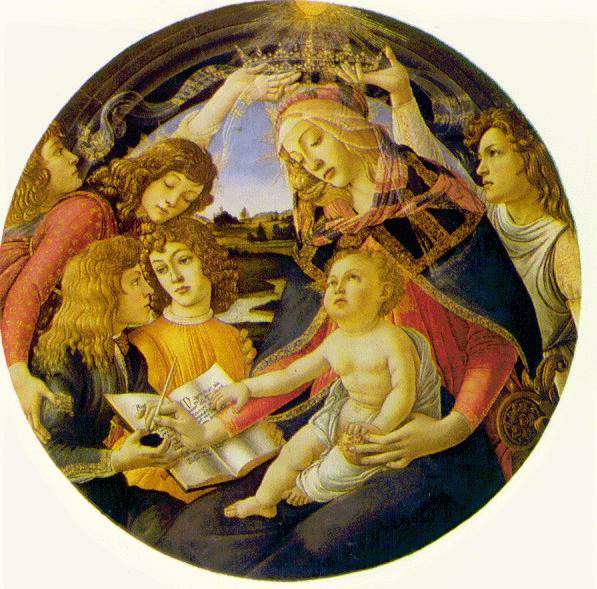
This is Sandro the student's rendition of Madonna. Uffizi's long corridors take you through time and let you trace the linear and lateral connectons among these artists. Genius as they were, they did not exist in vaccuum and dream up new styles and inventions all alone. Even Leonardo was not the inventor or the only practioner of the tricks of the perspective.
So I pondered in front of the soft, fragile, surreal figures in his giant paintings. It dawned on me only during the return trip to Uffizi what is so captivating and unique about his figures -- The EYES.
It is frustrating that I cannot show you through photographs why the eyes of his figures are so irresistable. For no photos can convey the transparent, airy quality of the eyes. They are paper thin sapphires that lets light shine through, and the iris and pupil painted with exquisite lines. The effect is out of this world. Beautiful and slightly eerie.
Thus, once again I urge anyone to go see the original of any significant art work. Photos and reproductions, however beautiful the print, cannot convey the soul of a piece. Any criticism or analysis without seeing the original has no credibility.
I was just about to comment on the Pagan themes in Birth of Venus and Spring as signs of the Renaissnace's effort of slight deviation from purely religious themes, when my friend told me about Botticelli's "purifiaction" and re-education process. After he had painted these nonreligious masterpieces, a church reformist, a monk named Fra Savonarola, stirred up a revoluation in Florence to impeach the decadent, unholy excesses of the Medici family who ruled the state. In chilling developments that later revoluations would repeat over and again, the mob stormed the Medici palace and chased them out of town. Brother Savonarola started a bonfire, which burned many decadent and unholy products of the corrupt lifestyle of the rich and privileged, including books and art, musical instruments and fancy clothes, anything that is sinful and immoral. Moved by the virtues of the revolutionary, Botticelli repented his own straying from God and voluntarily burned many of his un-Christian works in this "Bonfire of the Vanities." Hopefully he ended up clean and pure enough to go to heaven. (Ironically, Brother Savonarola was also severely against sodomy...)
The revolution, however, made a more earthly and predictable turn. As you can expect, the rich and powerful always win in the end, and people cannot live on idealism and purity of the soul alone. The Medicis made a comeback. The mob (same mob? another mob?) torn down the doors of his monastery and killed Brother Savonarola, and burned him on the same square where the Bonfire of the Vanities was lit not very long ago. Sometimes, history has a very reliable pattern...
4. Cellini the Crazy Guy.
My favorite statue in Florence of the first trip in 03 was Cellini's "Perseus Holding Medusa's Head." I was captivated by the exuberant violence and exquisite complexity of the bronze. The second time in Florence, I had the chance to see and fall in love with many more statues, but the power of the Perseus bronze remained every time I passed it by at Loggia dei Lanzi on Piazza della Signoria.

In front of all the white marble Giambologna sculptures, the dark, lean, dramatic Perseus stood out more than even the David replica in front of Palazzo Vecchio. The blood simultaneously squirts out of Medusa's twisted body under Perseus' foot and drips from her head in Perseus' hand. Also powerful is the base relief that depicts Perseus descending from the sky, sword and shield in hand, to the rescue of Andromeda. The relief is small and thin, but the expressions on the characters' face and the depth of perspective were astonishing. The horror and intensity almost matched Laocoon. Unfortunately, I could not find a clear photo of the relief on the Web. Here is a photo I took.
The terrible beauty of the statue was overwhelming and unlike anything else. What fascinates me was the simultaneous horror and calm in the statue, the quiet triumph and bloody corpse, victory was almost too much to bear, yet the hero shrugged it off with a sneer.
Creating such a complex bronze from caste and boilding metal must have posed a whole different set of difficulties from chiseling figures out of blocks of stone. But Cellini was perhaps the most renowned goldsmith of his time. Rather than obeying his musician father to inherit the trading of making musical instruments, he went his own way to apprentice with Florentine goldsmith masters. He executed many crowns, coins, and statuettes for the rich and powerful, from Popes to royalties. The guidebook called him one of the few artists of the time working in Michelangelo's shadow without being overwhelmed and able to make their own mark.
It is only natural that he was not overwhelmed by anyone's power, Michelangelo included. Cellini was a colorful nutcase with a life fit for a musical and a Dumas novel (indeed both have been written based on his adventures). As a teenager, he got into enough street fights to get kicked out of Florence. When he got to Rome, he was charging ahead in its battles with invading armies of Duke of Bourbon and bragged about killing the enemy general in his autobiography. Believe him or not.
He killed someone to avenge his brother. Stabbed a couple others. He served up beautiful works to Dukes and Popes but not much reverence and respect. (He is my kind of rebel.) He was constantly vascillating between being celebrated and being thrown in jail. The most revealing drama in his adventures might be his conflicts with the Pope's illegitimate son, which got him into a whole lot of trouble. He was locked up and almost executed. It was an aristocratic woman who rescued him from the gallows...
Cellini was basically an amoral, impulsive, self-congratulatory thug. He was violent, rough, grandiose. He obviously lacked any remorse for killing guys who offended him and any fear of God. But he was by no means simple. All the violent tendencies are expressed in his exquisite gold, silver, and bronze works of all sizes. The violence is a restrainted, nuanced, complex, full of layer upon layer of psychological texture. When I fell in love with Perseus, I knew nothing about Cellini. When I looked up his biography on Wikipedia, the mystery only deepened. Although I feel I have a fairly clear grip on the mind and temperment of Michelangelo, Cellini will probably have to be revealed in his half-written autobiography (there is an English translation in Project Gutenburg).
And finally, on the topic of the irresistable pull of the terrible beauty, Caravaggio's Medusa painted (fittingly) on a shield, is another perfect example:

5. The Subjects of Art.
After spending a week in Florence, we started to get the art fatigue and church fatigue. Paintings and sculptures began to blur together and seem indistinguishable. I started to miss Rome's vastness and variety that included pre-Catholic art and architecture. The church of Santa Maria Novella was a great place to see Massacio and Brunelleschi's un-peasant-like Jesus wood carving, but we were too mentally and physically exhausted to feel the full impact.
It was in Siena's excessively decorated, marble-floored cathedral that I let slip my disapproval rather than awe -- it was all too much, too much resources, genius, creativity, and everything spent on showing off and one-upping each other among the wealthy states in the name of God's glory. In front of the three hundred and thirty-three painting of the Madonna in Adoration of the Holy Infant, I told my friends about these eight "Model Plays" during the Chinese Cultural Revolution, which were the ONLY entertainment allowed for a decade. No other subjects were allowed in art, music, fiction, or nonfiction except a few prototype propaganda stories of the heoric revolutionaries and evil but stupid bad guys. No artists were allowed to stray into topics not sanctioned by the government. As such the public had access to nothing but the eight "Model" plays that were adapted into Peking Operas, ballets, movies, novels, comic books, other regional musical plays, over and over again.
The repetition in all the church-sponsored art reminded me of that. Everyone did Madonna, Jesus, the Saints, the Old Testment stories, and the Last Judgment. All the innovations, from the astounding perspective in Ghiberti's "Gate of Paradise" to Giotto's use of light to show that Madonna had knees and breasts under her garments, and the definitive viewpoint and optical illusion of Massacio's paintings on the wall of Santa Maria del Carmine Church, were practiced and carried out in the renditions of Church-dictated subjects. It had to be about St. Peter for this church and St. Catherine for that church. Every piece was commissioned. You can try your techniques but you can't paint anything other than what you're told to. The subjects permitted into sculptures and paintings were extremely narrow. You want to paint chickens? Flowers? The sunset? The carpenter on the street? You next door neighbor's six-year-old girl? You wife? Either you sneak them into the crowd watching St. John performing a miracle or hide it in the background behind Madonna's hut.
When observing the topics in the art works, I was once again reminded of economics as the fundamental but underappreciated force that shapes a society. When the church was the only payer, you got nothing but strictly religious products. But then the Medici family came along and wanted their egos stroked, so their own portraits found their ways into the paintings, the sculptures of saints had faces the whole city recognize, and even Greek mythological stories and figures are allowed to celebrate -- gasp -- the glory of the city state Firenze rather than the Catholic Church! Without the shift in economic power (although the Medici family still attained the ultimate political power through the Papacy, they felt secure enough to show off their earthly indulgences occasionally and let the the "retro movement" (Renaissance) take up more steam. Besides the Church and Medicis, merchants and various trades began to enjoy their own economical growth. Brunelleschi was hired by the Wool-makers' guild to design and build the famous dome. Some merchants had become rich enough to hire famous artists to paint portraits of themselves and their wives. When wealth and power were centralized in the hand of the Church alone, the subjects of art were restricted to the few figures and scenes from the bible. When wealth is distributed to a larger mix of groups, the diversity and creativity in art exploded.
I suspect that it was not only the newly emerged patrons who were tired of seeing the same paintings and sculptures, but the artists were conscious of the suffocation on their source of inspiration (or at least those with talent and creativity and independent thought). They must have also been fed up with painting nothing but the Annunciation and the Crucifixion.
6. "[The religion] does not tolerate passion and joy. It demands them."
I could not formulate a coherent argument for the sensual (and sometimes downright erotic) impression left by many an artwork of a sacred subject. In fact I was baffled again and again under paintings of half naked body of perfection that hung in otherwise somber churches and cathedrals. When they were listening to sermans about sins, hell, fire, and morality, did they look at the gorgeous paintings and sculptures feel a rush of yearning for earthly pleasures? It seemed contradictory. Of course nothing remotely human was allowed throughout the Dark Ages, but in the Renaissance more and more flesh glowed on church walls. How did people get away with this?
Beppe Severgnini's book "La Bella Figura" explained it. The church (at least in para- and post-Renaissance Italy) is not only a place for Masses and prayors, sermons and confessions, baptisms and ceremonies and funerals for the Italian people, but also a place to find stimulation in all senses, from visual to auditory to taste. And they are to be awed and moved and sent straight to unearthly ecstasy. Hence the gigantic paintings, the various depiction of beauty (including beauty of the ancient Greek and Roman), the artistic and technical miracles... Italians know a beautiful thing when they see it; they are not going to let a few technicalities like modesty, humility, and restrictive morality get in the way of creating and appreciating beautiful art. Not that a few powerful figures didn't try to hide nude bodies or private parts on antique sculptors, but destructions like "Bonfire of Vanities" were extremely few and massively opposed.
This claim has been repeated over and over -- that great, classical art, with all its naked women and men (sometimes even with suspiciously provocative poses and expressions), are fundamentally not "dirty pornography." Classical art is pure and clean -- transcending ordinary and earthly desires of the sexual nature. It is somehow virtuous and spiritual, floating somewhere in the clouds to be looked up to. It lifts and cleanses people's soul. It's not about sex.
It's a lie, of course. Art is about sex. Perhaps not literally about sexual acts and straight pornography (in fact pornography is invariably boring), but great art is very frequently connected with human desires, passions, instincts, flesh and blood, joy and pain. Art cannot move anyone if it is not intimate. The senses and the heart are front and center in both the artist and the viewer. To be successful, the classical art and the Renaissance art had to be infused with desires (often sexual or sensual or both) and passion when it was created and evoke desires and passion when it is seen. In this sense, modern art tends to be either more chast and intellectual (thus distancing themselves from a sensual experience) or more vulgar. The place of perfection somewhere in the middle, alas, has already been occupied by these damned Italians! What is a modern artist to do but smash a toilet bowl in a museum or draw a few lines that look like the female sexual organ without hope of a hint of eroticism?
